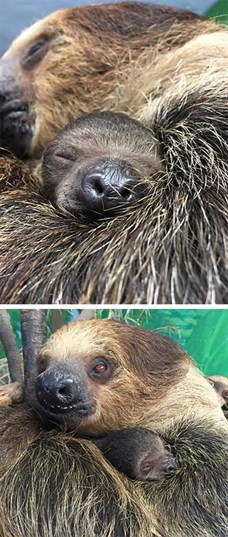Linne’s two-toed sloth born at Stone Zoo
Thursday November 10, 2016

The staff at Stone Zoo is pleased to announce the birth of a Linne’s two-toed sloth.
The baby, born November 2, is the offspring of Nero, age 11, and Lunesta, age 12. Visitors can see the baby, whose sex is not yet known, on exhibit with its parents inside Windows to the Wild.
“As with any new baby, we are closely monitoring its health. The baby appears healthy, bright and alert and is holding on tightly to its mother,” said Pete Costello, Assistant Curator of Stone Zoo, adding, “Lunesta is an experienced mom and she is being very protective of her baby.”
Zoo New England participates in the Linne’s Two-Toed Sloth Species Survival Plan (SSP), which is a cooperative, inter-zoo program coordinated nationally through the Association of Zoos and Aquariums (AZA). SSPs are designed to maintain genetically diverse and demographically stable captive populations of species. The birth is a result of a recommended breeding and is the third offspring for Nero and Lunesta.
Linne’s two-toed sloths are large, furry mammals that live in trees and are found in the tropical forests of South America. They spend almost their whole lives dangling upside-down from branches that they hold on to with all four clawed feet. While these animals move really well through the branches, once they are on the ground they are very slow and vulnerable to predators as they are not built for walking.
Sloths eat mainly a vegetarian diet of leaves and shoots, and they spend roughly 15 hours a day sleeping. Although they live in trees, sloths are not related to monkeys; rather, their closest relatives are the anteater and the armadillo.
Related:
- December 20, 2016: "Baby sloth, Molasses, receives first checkup"
- Learn more about sloths
- Zoodopt a sloth
- Visit our Kids' Corner to print a sloth mask
- Book a Behind-the-Scenes sloth tour
- Attend a Breakfast with the Sloth
Photos courtesy of Bridget Collins Lyman and Dayle Sullivan-Taylor

